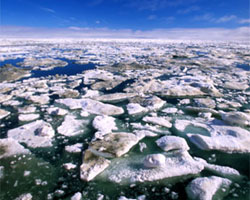Crossing the Line
 whoi.edu
whoi.eduAnother worrisome milestone in climate change has been crossed, scientists from the National Oceanic and Atmospheric Administration (NOAA) have found. Monitoring stations in the Arctic have recorded average carbon dioxide (CO2) concentrations of more than 400 parts per million. The rest of the world is not far behind, with average CO2 levels around 395 ppm and climbing.
Scientists describe the Arctic as a bellwether for the rest of the world’s climate. “The northern sites in our monitoring network tell us what is coming soon to the globe as a whole,” said Pieter Tans, an atmospheric scientist with NOAA’s Earth System Research Laboratory (ESRL) in Boulder, Colorado.
The carbon dioxide levels in the Arctic are particularly noteworthy because there is little human activity in the region, and therefore less local burning of fossil fuels. Levels in urbanized areas tend to be much higher because of local emissions of carbon dioxide from cars, factories and power plants. So the changes in the Arctic demonstrate that the atmosphere is changing more generally, researchers say.
The levels of carbon dioxide and other greenhouse gasses in the atmosphere help scientists predict how many degrees of warming are likely to result from climate change. Environmental advocates like Bill McKibben—founder of 350.org, a prominent campaign to limit global warming, say that greenhouse gas levels need to diminish to 350 ppm to reach what they call “climate safety.” But the trend has been in the opposite direction.
Taking into account the other greenhouse gasses like methane and nitrous oxide reveals that levels of gasses that warm the earth’s atmosphere are climbing at a striking rate. “When those gases are also considered, the global atmosphere reached a CO2 equivalent concentration of 400 ppm in 1985; and 450 ppm in 2003,” NOAA said in a May 31 press release.“Atmospheric CO2 levels are currently higher than they have been at any time during the last 800,000 years.”
Before the industrial revolution, average CO2 levels around the world ranged from 275 to 280 ppm. Much of the increase since then is attributable to burning carbon-rich fossil fuels like coal and oil, scientists say. It’s a trend that is likely to continue, absent major energy policy changes. Emissions of carbon dioxide from fossil fuels hit 34.8 billion tons worldwide in 2011, a rise of 3.2%, the International Energy Agency (IEA) announced recently.
European officials have agreed to work to keep global warming limited to two degrees Celsius, but experts agree that this is becoming increasingly unlikely. An average global temperature rise of two degrees C is generally associated with carbon dioxide equivalent levels of roughly 450 ppm.
“The news today, that some [Arctic] stations have measured concentrations above 400 ppm in the atmosphere, is further evidence that the world’s political leaders—with a few honorable exceptions—are failing catastrophically to address the climate crisis,” former Vice President Al Gore wrote in an email to the Associated Press. “History will not understand or forgive them.”
The impacts from even controlled levels of global warming are expected to be far reaching. There may be extensive economic and humanitarian damage, a growing number of economists predict. An average temperature rise of 2-3 degrees in average global temperatures could leave roughly 15% of the world’s population exposed to droughts or floods, and lowered agricultural production could put several hundred million people at risk of starvation, according to a 2006 report by Nicholas Stern, a former chief economist of the World Bank.
In 2009, researchers from UCLA found that “the only time in the last 20 million years that we find evidence for carbon dioxide levels similar to the [then] modern level of 387 parts per million was 15 to 20 million years ago, when the planet was dramatically different.” Dramatically different indeed. That was during a period called the Middle Miocene, when there was no permanent Arctic ice cap, sea levels were far higher, and massive storms like monsoons were far more common, scientists say.

